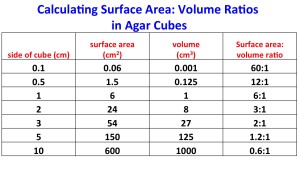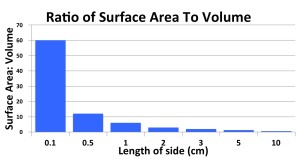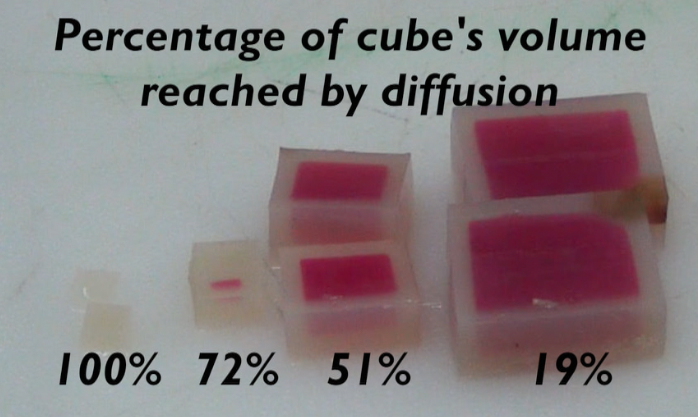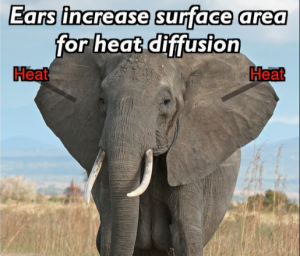- Looking for a student learning guide? It’s on the main menu for your course. Use the “Courses” menu above.
- Click for the handout I use when I do this lab with my students.
- If you’ve already watched the video, click here, or scroll down below the video to start interacting.
1. Surface Area Volume Ratios and Life: The Basic Idea
For the most part, life occurs on a very small scale. Life is based on cells, and cells (with a few exceptions like egg cells) are small. How small? A eukaryotic cell is typically about 30 micrometers in diameter. That’s 30 millionths of a meter. A prokaryotic cell (the type of cell found in bacteria) can be anywhere from 300 times smaller to five times smaller. Why are cells, the basic units of life, so small?
The answer lies in the relationship between a cell’s surface area and its volume. Surface area is the amount of surface an object has.
- For a cube, the formula for area is (length of a side)2 x 6.
- For a sphere, the formula for area is 4 Π r2
Volume is the amount of space inside something.
- For a cube, the formula for volume is (length of a side)3.
- For a sphere, the formula is 4/3 Π r3
The surface area to volume ratio is an object’s surface area divided by its volume. So, for a cube that’s one centimeter on a side,
- the surface area is 6cm2 (1cm x 1cm x 6),
- the volume is 1 cm3 (1cm x 1cm x 1cm), and
- the surface area to volume ratio is 6 units of surface: 1 unit of volume
As you can see from the formulas, surface area is a square function (side 2 x 6), while volume is a cubic function (side)3. As a result, as the size of an object increases, its ratio of surface area to volume decreases. Conversely, as the size of an object decreases, its ratio of surface area to volume increases.

Study the table above, which shows the area, volume, and surface area: volume ratio for a variety of cubes. Note that in a cube that’s 0.1cm on a side the surface area: volume ratio is 60:1. This ratio falls to 0.6:1 in a cube that’s 10cm on a side.
This becomes even clearer in the chart below.

But how does this relate to the size of cells? Cells are constantly exchanging substances with their environment, and this exchange largely happens by the diffusion of materials through the cell membrane, the outer boundary of a cell. Cells need to be small so that they have enough surface for molecules to be able to diffuse in and out. On a much larger scale, you can see this in the picture below.

This picture is a still from the main demonstration shown in the Surface Area, Volume, and Life video. The cubes are made of agar, a seaweed extract. The agar contains a pH indicator, and the cubes are fuchsia (dark pink) on the inside because their initial pH is basic. When placed in vinegar (an acid), the vinegar diffuses into the cubes. As the vinegar diffuses in, the pH indicator changes from fuchsia to white.
This is what the cubes look like after six minutes. Note that 100% of the smallest cube’s volume has been reached by the vinegar, while only 19% of the largest video is reached by diffusion. The basic idea: small size results in a high surface area to volume ratio, which enhances diffusion. And that’s why cells are small.

The same principle explains a variety of biological phenomena. Why do elephants have big ears? Because elephants are huge, their bodies have a very low surface area to volume ratio. This makes it very difficult for heat to diffuse away from the elephant’s body. To compensate, elephants have evolved huge, flat ears. The ears, being flat, increase the elephant’s surface area, while barely increasing the volume. Blood in the ears can release heat into the environment.

Flattening out structures is an adaptation that also explains why flatworms can survive without any specialized system for distributing oxygen or carbon dioxide throughout their bodies. Because they’re flat, they have a very high surface area to volume ratio. This allows oxygen to diffuse from water directly to their body cells, and for carbon dioxide to diffuse from their body cells back out to the surrounding environment.

Reducing the surface area to volume ratio can also be an adaptive strategy. Think about marine mammals. None of them are very small (the size of mice or even rats). The smallest marine mammals are otters, and it’s no coincidence that most marine mammals are relatively large (think of walruses, dolphins, manatees, etc.). One marine mammal, the blue whale, is the largest animal ever to have evolved. Why are marine mammals large? It’s instructive to compare marine mammals with elephants. Whereas elephants evolved huge ears as a way to enhance heat diffusion by increasing their surface area to volume ratio, marine mammals have evolved large sizes as a way of decreasing their surface area to volume ratio, as a way of decreasing heat loss. Look again at figure 3 above. The large cube, with its low surface area to volume ratio, has relatively little diffusion happening over time. And in terms of heat exchange, that’s advantageous for mammals living in cool ocean water. In other words, just by being large, marine mammals were able to evolve a strategy that enabled them to diminish heat loss.
2. Checking Understanding
[qwiz qrecord_id=”sciencemusicvideosMeister1961-surface-area-volume 1 (AP)M.C”]
[h]Surface Area, Volume, and the Surface Area-to-Volume Ratio
[i]Grab a pencil and some scratch paper. Some of these questions involve a few calculations!
[q]The formula for the surface area of a cube is (side)2 multiplied by ____
[textentry single_char=”true”]
[c]Ng ==[Qq]
[f]VGhhdCYjODIxNztzIHJpZ2h0LiBUaGUgZm9ybXVsYSBmb3IgdGhlIHN1cmZhY2UgYXJlYSBvZiBhIGN1YmUgaXMgKHNpZGUpMiA=bXVsdGlwbGllZCBiecKgNi4=[Qq]
[c]Kg==[Qq]
[f]Tm8uIFRoaW5rIG9mIGhvdyBtYW55IHNpZGVzIGEgY3ViZSBoYXMu[Qq]
[q]The formula (side)3 will give you the _______ of a cube
[c]c3VyZmFjZSBhcmVh[Qq]
[c]dm9s dW1l[Qq]
[f]Tm8uIFRoZSBmb3JtdWxhIGZvciB0aGUgc3VyZmFjZSBhcmVhIG9mIGEgY3ViZSBpcyAoc2lkZSk=MsKgeMKgNi4=[Qq]
[f]WWVzLiBUaGUgZm9ybXVsYSAoc2lkZSk=Mw==IHdpbGwgZ2l2ZSB5b3UgdGhlIA==dm9sdW1lwqBvZiBhIGN1YmUu[Qq]
[q]A cube with a 2 cm side has a surface area of ____ cm2
[c]NA==[Qq]
[c]OA==[Qq]
[c]MTY=[Qq]
[c]Mj Q=[Qq]
[f]Tm8uIFRoZSBjdWJlJiM4MjE3O3Mgc3VyZmFjZSBhcmVhIGZvcm11bGEgaXMgKHNpZGUpMg==IFggNi4gVGFrZSAyIGNtLCBzcXVhcmUgaXQsIHRoZW4gbXVsdGlwbHkgYnkgNiBmb3IgeW91ciBhbnN3ZXIu[Qq]
[f]Tm8uIFRoZSBjdWJlJiM4MjE3O3Mgc3VyZmFjZSBhcmVhIGZvcm11bGEgaXMgKHNpZGUpMg==IFggNi4gVGFrZSAyIGNtLCBzcXVhcmUgaXQsIHRoZW4gbXVsdGlwbHkgYnkgNiBmb3IgeW91ciBhbnN3ZXIu[Qq]
[f]Tm8uIFRoZSBjdWJlJiM4MjE3O3Mgc3VyZmFjZSBhcmVhIGZvcm11bGEgaXMgKHNpZGUpMg==IFggNi4gVGFrZSAyIGNtLCBzcXVhcmUgaXQsIHRoZW4gbXVsdGlwbHkgYnkgNiBmb3IgeW91ciBhbnN3ZXIu[Qq]
[f]RXhjZWxsZW50LiBJZiBhIGN1YmUmIzgyMTc7cyBzaWRlcyBhcmUgMiBjbSBsb25nLCB0aGVuIGl0cyBzdXJmYWNlIGFyZWEgaXMgMjQgY20=Mg==LCBjYWxjdWxhdGVkIGJ5IHVzaW5nIHRoZSBmb3JtdWxhIChzaWRlKQ==Mg==IFggNg==[Qq]
[q]A cube with a 2 cm side has a volume of ____ cm3
[textentry single_char=”true”]
[c]OA ==[Qq]
[f]RXhjZWxsZW50LiBJZiBhIGN1YmUmIzgyMTc7cyBzaWRlcyBhcmUgMiBjbSBsb25nLCB0aGVuIGl0cyB2b2x1bWXCoGlzIDjCoGNtMw==[Qq]
[c]Kg==[Qq]
[f]Tm8uIFRoZSBmb3JtdWxhIGZvciB0aGUgdm9sdW1lIG9mIGEgY3ViZSBpcyAoc2lkZSk=M8KgeMKgNi4gSnVzdCBwbHVnIGluIDJjbSB0byB0aGlzIGZvcm11bGEgYW5kIHlvdSYjODIxNztsbCBoYXZlIHlvdXIgYW5zd2VyLg==[Qq]
[q]An object’s surface-area-to-volume ratio is that object’s
[c]dm9sdW1lIGRpdmlkZWQgYnkgaXRzIHN1cmZhY2UgYXJlYQ==[Qq]
[c]KHZvbHVtZSk=Mg==IG11bHRpcGxpZWQgYnkgKGFyZWEpMg==[Qq]
[c]c3VyZmFjZSBhcmVhIGRp dmlkZWQgYnkgdm9sdW1l[Qq]
[c]c3VyZmFjZSBhcmVhIG1pbnVzIHRoZSB2b2x1bWU=[Qq]
[f]Tm8uIEhlcmUmIzgyMTc7cyBhIGhpbnQ6IGl0JiM4MjE3O3MgdGhlIHN1cmZhY2UgYXJlYTogdm9sdW1lIHJhdGlv[Qq]
[f]Tm8uwqBIZXJlJiM4MjE3O3MgYSBoaW50OiBpdCYjODIxNztzIHRoZSBzdXJmYWNlIGFyZWE6IHZvbHVtZSByYXRpbw==[Qq]
[f]WWVzLiBJdCYjODIxNztzIHRoZSBzdXJmYWNlIGFyZWEgZGl2aWRlZCBieSB0aGUgdm9sdW1l[Qq]
[f]Tm8uwqBIZXJlJiM4MjE3O3MgYSBoaW50OiBpdCYjODIxNztzIHRoZSBzdXJmYWNlIGFyZWE6IHZvbHVtZSByYXRpbw==[Qq]
[x]
[restart]
[/qwiz]
3. Interactive Reading: Applying the surface area to volume ratio.
[qwiz qrecord_id=”sciencemusicvideosMeister1961-surface-area-volume (AP)I.R.”]
[h]Surface Area to Volume Ratios: Interactive Reading
[i]This reading relates to what you would have observed in the video (so make sure you’ve watched that first).
[q]As a cube gets bigger, its ratio of surface area to volume __________.
As a cube gets smaller, its ratio of surface area to volume _________.
As objects get ______, the volume increases so much more rapidly than surface area because volume is a ______ function, while area is a _______ function.
[l]bigger
[fx] No, that’s not correct. Please try again.
[f*] Great!
[l]cubic
[fx] No. Please try again.
[f*] Great!
[l]increases
[fx] No, that’s not correct. Please try again.
[f*] Great!
[l]square
[fx] No, that’s not correct. Please try again.
[f*] Excellent!
[l]decreases
[fx] No, that’s not correct. Please try again.
[f*] Great!
[q]The movement of a substance from where it is more concentrated to where it is less _______________ is called ____________.
In our lab, the vinegar entered the agar cubes by ___________.
For the vinegar to enter the cubes, it had to go through the cube’s outer ___________.
[l]concentrated
[fx] No. Please try again.
[f*] Excellent!
[l]diffusion
[fx] No. Please try again.
[f*] Good!
[l]surface
[fx] No. Please try again.
[f*] Excellent!
[q]Because a 3 cm cube had only ____ units of surface area for every ____ unit of volume, the vinegar was only able to diffuse into a relatively ____ percentage of the cube’s volume.
Because a .5 cm cube had ______ units of surface area for every ____ unit of volume, the vinegar was able to reach a _____ percentage of the cube’s volume.
[l]high
[fx] No, that’s not correct. Please try again.
[f*] Correct!
[l]low
[fx] No. Please try again.
[f*] Good!
[l]one
[fx] No, that’s not correct. Please try again.
[f*] Good!
[l]twelve
[fx] No, that’s not correct. Please try again.
[f*] Good!
[l]two
[fx] No. Please try again.
[f*] Correct!
[q labels = “top”]In another demonstration, we cut a flat sheet of agar. A flat sheet has a lot of _____________ compared to its _______, Because of this _____ surface area to volume ratio, the vinegar was able to _______ into a _____ percentage of the cube’s volume.
[l]diffuse
[fx] No. Please try again.
[f*] Great!
[l]high
[fx] No. Please try again.
[f*] Good!
[l]surface area
[fx] No, that’s not correct. Please try again.
[f*] Good!
[l]volume
[fx] No. Please try again.
[f*] Correct!
[q labels = “top”]Pretend that the large cube in the diffusion lab in our video was a cell, and the vinegar was food. In this analogy, the surface of the cube would be the __________ of the cell, and the inside of the cube would be the __________. The part of the “cell” that remained pink-ish would be _________ because little or no food would have been able to _______ into it.
[l]cytoplasm
[fx] No, that’s not correct. Please try again.
[f*] Correct!
[l]diffuse
[fx] No. Please try again.
[f*] Great!
[l]membrane
[fx] No, that’s not correct. Please try again.
[f*] Excellent!
[l]suffering
[fx] No. Please try again.
[f*] Excellent!
[q labels = “top”]Cells are small for the following reason: compared to its _______, anything that’s _______ has a lot of surface area. This makes it _______ for things to diffuse in and out of cells
Cells in your intestine are very wavy on top. This gives them a particularly high surface area to ________ ratio, making it easy for food to __________ into them.
[l]diffuse
[fx] No. Please try again.
[f*] Good!
[l]easy
[fx] No, that’s not correct. Please try again.
[f*] Excellent!
[l]small
[fx] No, that’s not correct. Please try again.
[f*] Excellent!
[l]surface area
[fx] No, that’s not correct. Please try again.
[f*] Good!
[l]volume
[fx] No. Please try again.
[f*] Excellent!
[q labels = “top”]Gills in fish consist of lots of thin flaps of tissue. These thin flaps provide lots of ___________ for absorbing ___________ from the water.
Heat also diffuses in and out through an animal’s surface. Because they’re so big, whales have a very ___ surface area to volume ratio. This makes it _______ for heat to escape from their bodies, which helps them survive in _____ water.
[l]cold
[fx] No, that’s not correct. Please try again.
[f*] Great!
[l]difficult
[fx] No, that’s not correct. Please try again.
[f*] Good!
[l]low
[fx] No. Please try again.
[f*] Excellent!
[l]oxygen
[fx] No, that’s not correct. Please try again.
[f*] Correct!
[l]surface area
[fx] No, that’s not correct. Please try again.
[f*] Great!
[/qwiz]
Next steps
- Introduction to Cells (next tutorial in this series)
- Cell Structure and Function Main Menu
